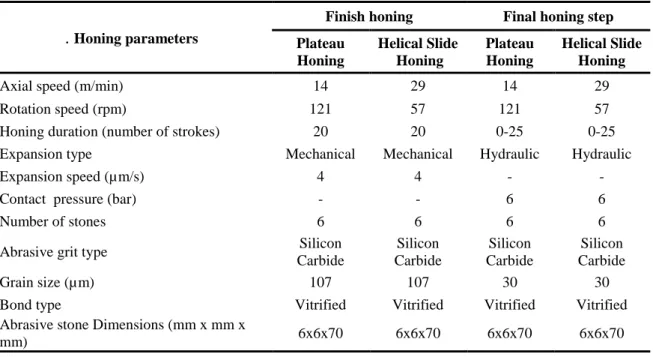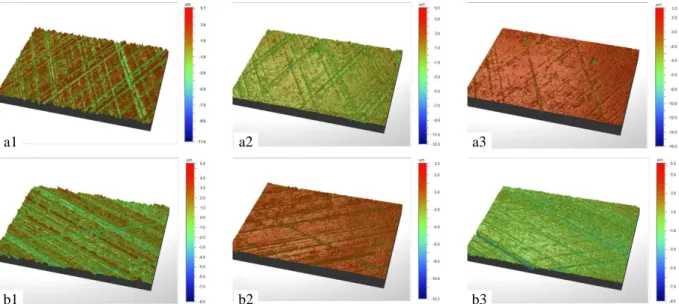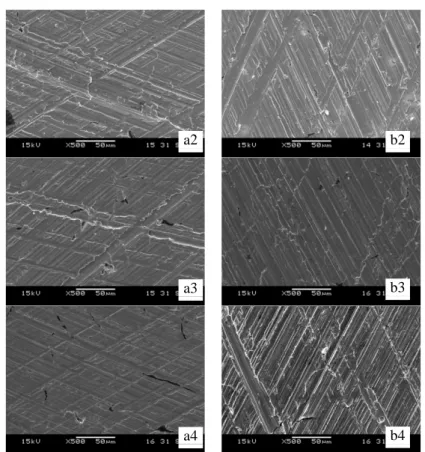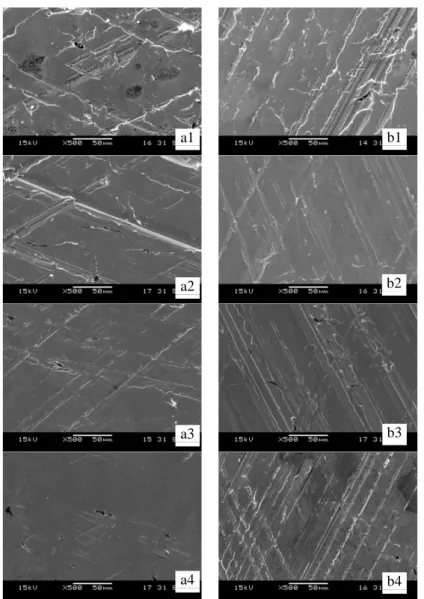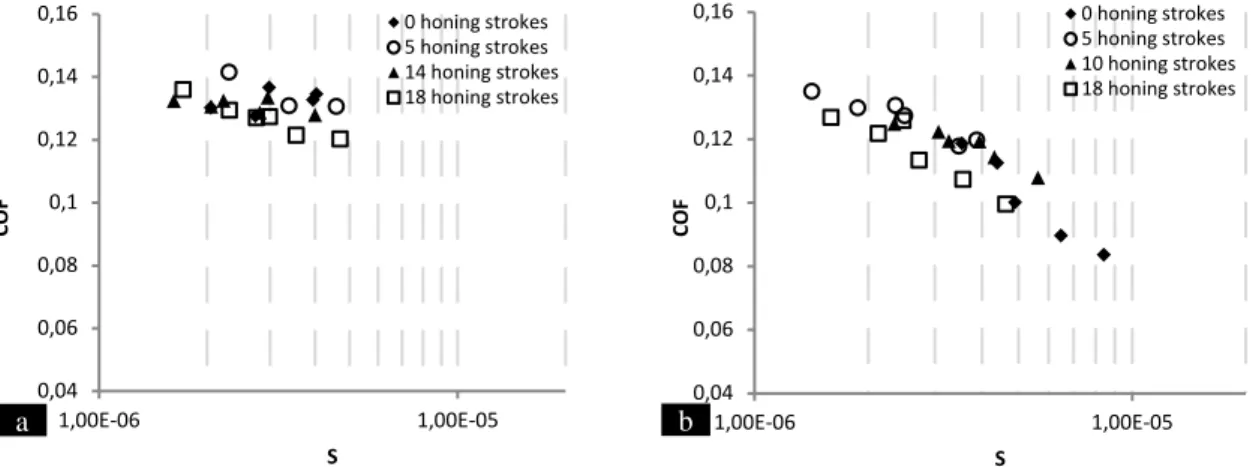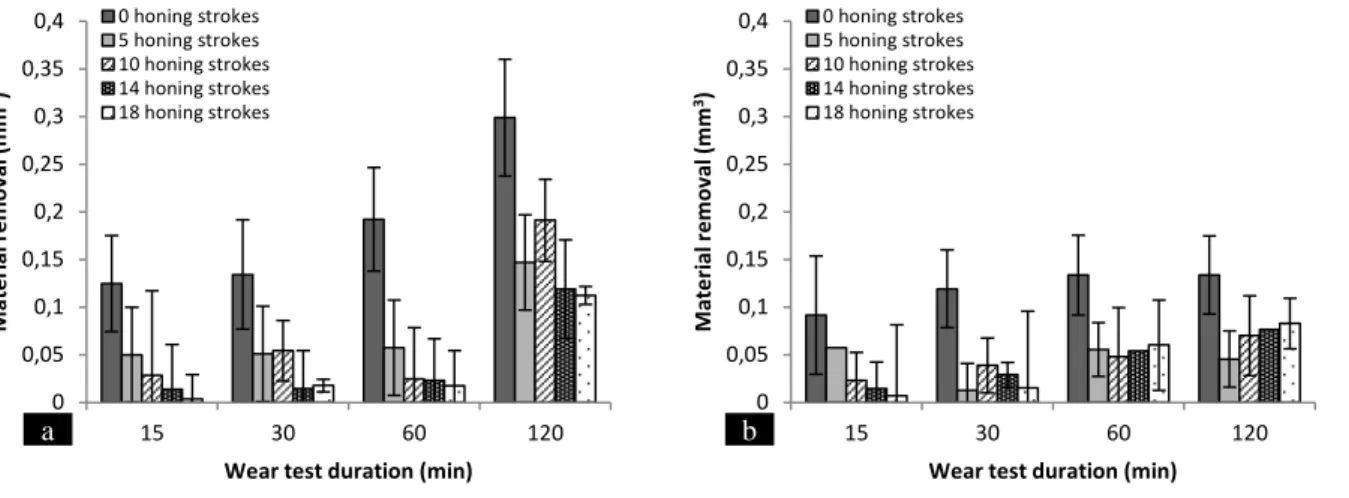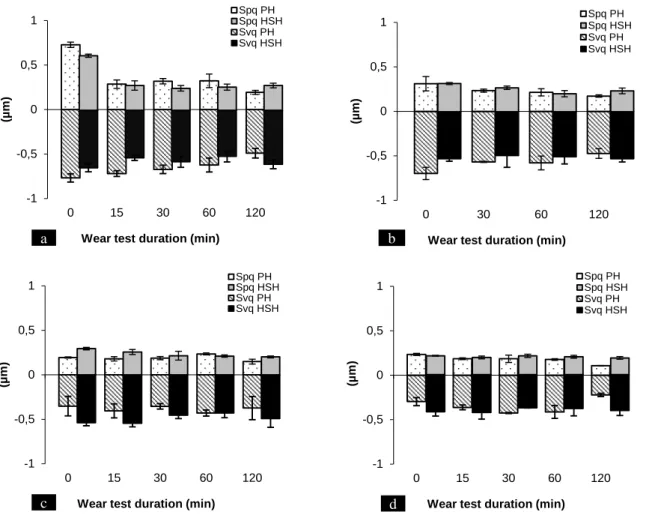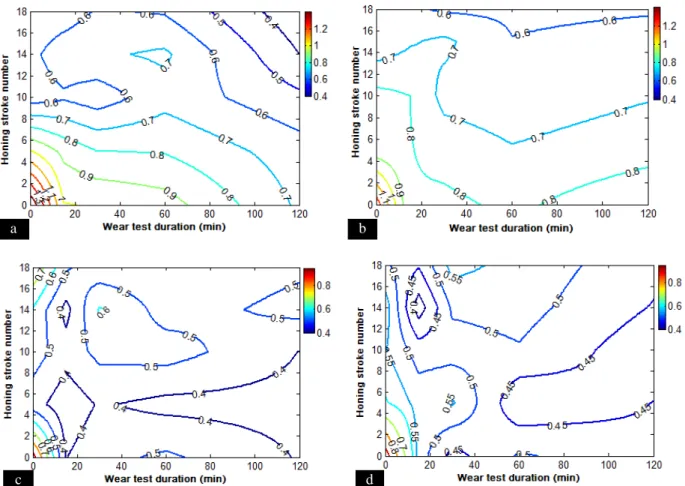This is an author-deposited version published in: https://sam.ensam.eu
Handle ID: .http://hdl.handle.net/10985/9819
To cite this version :
Mohammed YOUSFI, Sabeur MEZGHANI, Ibrahim DEMIRCI, Mohamed EL MANSORI
-Smoothness and plateaudness contributions to the running-in friction and wear of stratified helical slide and plateau honed cylinder liners - Wear - Vol. 332-333, p.1238–1247 - 2015
Any correspondence concerning this service should be sent to the repository Administrator : archiveouverte@ensam.eu
Smoothness and plateaudness contributions to the running-in
friction and wear of stratified helical slide and plateau honed
cylinder liners
M. Yousfi
1,2*,S. Mezghani
1, I. Demirci
1and M. El Mansori
11Arts et Métiers ParisTech, MSMP, Rue Saint Dominique, Châlons-en-Champagne, France 2Renault S.A.S., Technocentre, Guyancourt, Paris area, France
*mohammed.yousfi @ensam.eu
Received Date Line (to be inserted by Production) (8 pt)
Abstract
Cylinder liner surface has a great influence on frictional and wear performances of combustion engines during the running-in period. Two surface texture anisotropies produced by plateau honing (PH) and helical slide honing (HSH) processes (which consist of 50° and 130° cross-hatched grooves, respectively) are commonly used in automotive industry for thermal combustion engine cylinder liners. They are generated by a three stages process. The first stage, rough honing, removes enough material to obtain the desired cylindricity. The second step, finish honing, generates the honed texture which consists of grooves with a specific cross-hatch angle. The third stage permits to reduce the surface peaks and therefore allows varying plateau superficial roughness amplitude.
This paper is devoted to studying the influence of respectively smoothness and plateaudness on honed surface wear and friction performances during running-in. For that, HSH and PH textures are generated using different final honing stage durations in order to obtain different levels of surface peak clipping. Then, friction, wear and surface topography evolution were analyzed during running-in tests on a reciprocating ring-liner tribometer under mixed lubrication regime. The results show that the superficial surface roughness generated by helical slide honing has a very low contribution into friction. This is promising for the honing process optimization, in which the third stage can be significantly reduced or avoided.
1. Introduction
In the automotive industry, face to a stringent legislation for the limitation of harmful polluting emissions, manufacturing improved efficiency vehicle engines is a major objective [1]. Several experimental and numerical studies showed that cylinder liner texture influences significantly on engine functional performances (friction, wear, oil consumption, etc.) [2–4]. Different stratified honing techniques (plateau honing, helical slide honing, slide honing, etc.) are used in industry [5].
The main differences between the processes are generally due to the produced surface smoothness (surface roughness), plateaudness (plateau and valleys ratio or/and anisotropy (cross-hatch angle)) [5,6]. A study based on a numerical hydrodynamic contact model explained the choice of honing cross-hatch of these industrial processes [7]. It determined two optimal ranges of crosshatch angles (25°-60° and 115°-140°) in hydrodynamic lubrication regime for lower friction performances. Other studies confirmed these results [8–11].
Two industrial processes plateau honing (PH) with a cross-hatch angle of 50° and a Helical slide honing (HSH) with a cross-hatch angle of 130°are interesting for their frictional performance. These very widely used processes are a succession of three honing stages [5,6,12,13]. The first stage often categorized as rough honing establishes the form of the bore. The so called ″finish honing″ creates the basic surface texture of the hole is the second operation. For plateau (PH) and helical slide honing (HSH), the final finishing stage is mainly used to generate plateaudness surfaces (with smooth plateaus and quite deep valleys) that resemble to running-in surfaces and hence significantly reduce wear of the liner surface [14]. This also enables to obtain a smoother surface in which, according to Horng and Lee [15], large valley are transformed to many small valleys. However, after running-in engine test, it has been shown that the wear of HSH surface is reduced as compared to a Plateau honed surface [5].
Concerning the surface topography, Mezghani et al. [1,4] demonstrated, in the case of PH process that smooth texture with lower plateau roughness and valley depth contributes to reduce frictional performances of honed surfaces. Nevertheless, it has been shown, through numerical studies that Helical Slide Honed surfaces are less sensitive to the plateaudness i.e., to superficial roughness [6]. The plateau/valleys ratio can be maintained quite high without increasing friction coefficient in mixed lubrication regime [10,6]. Moreover, the reduced roughness topography of HSH surface, compared to plateau honed is mainly due to the high honing duration during the last stage [5,16,17].
In this paper, the influence of smoothness and plateaudness of PH and HSH surfaces on friction is revealed during running-in process. Then, PH and HSH surfaces with different roughness and plateau/valleys ratios were generated by varying the third honing stage duration. Theirs frictional performances, wear and surface topography evolution have been compared experimentally using a linear-ring tribometer.
Nomenclature
pq
S
Root-mean square of the superficial plateau roughness of cylinder surface after plateau honing (µm)vq
S
Root-mean square of the valleys depth of cylinder surface after plateau honing (µm)µ
D Lubricant Viscosity, Pa.sv Mean Sliding velocity during friction and wear tests FN Normal contact force between ring and liner surface FT Tangential contact force between ring and liner surface ly Contact width between ring and liner surface
HSH Helical Slide Honing or Helical Slide Honed (surface) PH Plateau Honing or Plateau Honed (surface)
COF Coefficient of friction
S Sommerfeld number y N D l F v S =µ × 2. Experimental procedure 2.1 Honing experiments
Stratified Honing experiments have been carried out on an instrumented vertical honing machine with an expandable tool (NAGEL no. 28-8470) (Figure 1). The considered part is a crankcase that consists of four lamellar grey cast iron cylinder liners for diesel engines. First, during the rough honing stage, all of the process parameters are similar for all the honed bores. Then, for the finish stage, two different kinematics are used: a plateau honing kinematic with a cross-hatch angle of 50° and a HSH one with a cross-hatch angle of 130°. To obtain that, two different couples of rotation speed and axial speed have been used. For plateau honing process (PH) a high rotational velocity is used whereas for the helical slide honing process (HSH), the axial speed is
increased. During the final stage, in order to generate different roughness levels and plateaudness ratios [4,6], the surfaces are honed with HSH and PH kinematics using a hydraulic expansion at different honing durations (from 0 to 25 strokes). All the other working variables were kept constant. The details of the most important applied process condition are represented in Table 1.
Figure 1. (a)Vertical honing machine with an expansible tool ; (b) Schematic representation of a honing head and its motion.
Table 1. Honing operating conditions in the finish and final honing stages.
.
Honing parametersFinish honing Final honing step
Plateau Honing Helical Slide Honing Plateau Honing Helical Slide Honing
Axial speed (m/min) 14 29 14 29
Rotation speed (rpm) 121 57 121 57
Honing duration (number of strokes) 20 20 0-25 0-25
Expansion type Mechanical Mechanical Hydraulic Hydraulic
Expansion speed (µm/s) 4 4 - -
Contact pressure (bar) - - 6 6
Number of stones 6 6 6 6
Abrasive grit type Silicon
Carbide Silicon Carbide Silicon Carbide Silicon Carbide Grain size (µm) 107 107 30 30
Bond type Vitrified Vitrified Vitrified Vitrified
Abrasive stone Dimensions (mm x mm x
mm) 6x6x70 6x6x70 6x6x70 6x6x70
The honed crankcases were first cut in order to extract rectangular portions with dimensions of 140 mm
(
length)x 110 mm (width) x 35 mm (height) (Figure 2) of honed bores, in order to facilitate optical measurements and to carry out more easily tribological tests and surface topography measurements.Figure 2. Rectangular specimen cut from cylinder liners
2.2 Tribological tests
Friction and wear tests are carried out once for each honing configuration at temperature of 27°C +/- 2°C through a reciprocating ring-liner tribometer driven by a slider-crank mechanism with a stroke length of 80 mm (Figure 3). The contact surface is lubricated using 10W40 semi-synthetic oil (
µ
D equal to 0.08 Pa.s at 40°C). The total wear test duration is 120 min where additional amount of lubricant is added (2-3 ml) every 20 min. The normal force and engine velocity used for these tests are 100 N and 174 rpm (the average linear velocity equivalent to 0.46 m/s) respectively.Figure 3. Reciprocating ring-liner tribometer
Friction tests are undertaken in mixed lubrication regime at two load levels 50 N and 100 N and three different reciprocating velocities 174, 232 and 290 rpm to reach different Sommerfeld numbers (S) [18] . Due to a small contact surface between the ring and liner surface (around 2-3 mm2), the contact pressure is high and it can reach up to 50MPa.
Friction measurements were also recorded after 0, 15, 30, 60 and 120 min test durations. Friction coefficient is calculated using the ratio between the average normal force FN over the average tangential force FT evaluated with strain gauges. Tribometer repeatability uncertainty is evaluated at about 9% (after preliminary validation
Electrical engine
Liner specimen Rotating slider crank
mechanism Ring
tests). Moreover, negative surface replicas made of a silicon rubber material (Struers, Repliset F5) were used on the worn surfaces to assess the 3D texture of honed surfaces at the mid-height of the cylinder bore specimen [12].
2.3 Surface topography measurements
Surface topography measurements are carried out before and after each tribological test. A three-dimensional analysis was then undertaken at the mid-height (i.e. at the dead center) of liner samples. Measurements were performed by a three-dimensional white light interferometer, WYKO 3300 NT (WLI). The representative surface topography area is determined by several tests showing the repeatability of the measure in different locations in the considered region. The surface is then sampled at 640x480 points with the same step scale of 1.94 µm in the -x and -y directions (the surface size is therefore 1.2 mm x 0.93 mm). The form component is removed from the acquired 3D data using least square method based on a cubic spline function. Figure 4 and Figure 5 show HSH and PH isometric topographies at different honing strokes and running-in durations, respectively.
Honed surface wear are characterized by separation of plateau and valleys components for tracking wear evolution during low material removal process [4,17,19,20]. Different approaches are developed in literature to characterize separately the plateau and valley components of honed surfaces by theirs average quadratic heights (Spq) and (Svq), such as the 3D extension of ISO 13565-3 standard based on the plot of the bearing curve on normal probability scale [17,21] and the two-level morphological filtering [4,20]. In this study, the morphological decomposition method is applied.
Figure 4 PH (a) and HSH (b) 3D topopographies generated with respectively (1) 0, (2) 10 and (3) 18 honing strokes (at the third honing stage) before running-in tests
Figure 5 PH (a) and HSH (b) 3D honed surface topopographies generated after (1) 0 min, (2) 30 min and (3) 60 min running-in test when the third honing stage was not performed.
3. Results and discussions
The analysis of the experimental results is based on the simultaneous characterization of the surface finish to understand surface topography modifications and the wear of the cylinder bore. Then, the surface frictional performances are considered through trials on tribometer. Finally, the correlation between surface finish and friction surface performance is discussed for the purpose of stratified honing process optimization.
a1 a2 a3
b1 b2 b3
3.1 SEM observations
The surface textures of engine bores are examined after each honing process with different durations of the final honing stage before and after wear tests (120 min). Figure 6 shows the evolution of surface texture of both PH and HSH cylinder liners before wear tests. As shown in Figure 6a, before the final honing stage (0 strokes), smear phenomenon appears on both PH and HSH surfaces. Then, as the honing stroke number increases, this smear phenomenon is progressively removed and the surfaces become more regular. Moreover, plateau surface appears smoothed and initial valleys (generated during the finish stage) seem to be reduced. However, it appears, after 18 strokes that PH surface presents smoother texture with lower valleys depth, comparatively to HSH one. The same behaviour can be observed through 3D measurement with the interferometer (Figure 4). Furthermore, at this moment, we can observe a higher concentration of graphite lamellas (dark marks) for PH surface.
These observations, confirm, as demonstrated in [16,17], the generation of a uniform and consistent texture by honing process. Moreover, it shows, according to Mezghani et al in [4], two honing process mechanisms which are the “plateauing” and the “smoothing”. The plateauing mechanism occurs during first strokes (from 0 to 10 strokes) of the third honing step and is characterised by a surface with smooth plateaus and deep valleys [14]. After 10 strokes, smoothing mechanism occurs with both reduced plateau and valley roughness.
a1
A
b1
Figure 6 SEM photographs of unworn (a) PH and HSH (b) surfaces honed with a final honing test of (1) 0, (2) 5, (3) 10 and (4) 18 strokes.
Figure 7 shows the evolution of surface topography of both PH and HSH cylinder liners after 120 min ring-liner wear tests. In this figure, we can observe that PH and HSH surfaces behave differently during wear tests. For PH texture, initial surface (before wear test) influences a lot on the aspect of worn surface. With a low honing stroke number (0 and 5), the surface texture is very smooth with the presence of deeper valley (generated during the finish honing stage). Here, lower valleys are completely erased. With an increase in honing stroke number, deeper valleys are in turn progressively erased. With a high honing stroke number (18 strokes), we can see only few interrupted grooves. Concerning HSH surface, texture is smoothed, but deeper valleys are maintained although their depth is reduced. The same behaviour is observed through 3D interferometer measurements (Figure 5). These results are in accordance with Schmid et al [5] observations, through real engine tests about the reduced wear of HSH textures. However, due to mixed and boundary regime during running-in conditions, valley depth of PH surfaces is less important than what is observed in fired-engine conditions where hydrodynamic and mixed regime are predominant [22].
a2
A
b2A
a3A
b3A
a4A
b4A
For both HSH and PH texture, very small cavities can be seen on the surface maybe due to cast iron porosity caused by graphite nodules [23].
Figure 7 SEM photographs of worn (a) PH and HSH (b) surfaces after 120 min wear test and with a final honing test of (1) 0, (2) 5, (3) 10 and (4) 18 strokes.
3.2 Running-in friction map for PH and HSH honed surfaces
Figure 8 represents a 3D map of the COF function of the honing strokes number at the final honing stage and the running-in wear test duration respectively for PH and HSH honed surface texture. It shows that friction coefficient is reduced when the honing strokes increases i.e. smoother surface finishes. Furthermore, in the same
a1
A
b1A
a2A
b2A
a3A
b3A
a4A
b4A
test condition, HSH surface texture leads to a lower friction and tend to enter to mixed lubrication regime earlier than PH surfaces. This confirms some numerical results in mixed lubrication regime [10,6]. However these results need to be confirmed with firing engine experiments which take into account real engine conditions.
Figure 8 Evolution of friction coefficient (COF) at S=5.0×10-6 in function of wear test duration and honing stroke number for (a) PH and (b) HSH surfaces.
Figure 9 depicts the evolution of the coefficient of friction (COF) expressed with Somerfield number (S) for PH and HSH surfaces respectively, generated at different honing strokes during the final honing stage. It shows that lubrication boundary regime is observed practically for all the PH surface finish (usual boundary COF of ~0.12 for chromium/cast iron contact). Mixed regime is reached and COF significantly decreases with S number only for a surface generated with highest honing duration (18 strokes). Whereas, for HSH surface textures mixed regime (COF lower than 0.12 for chromium/cast iron contact) can be attained until five honing strokes at the final honing stage. 0,04 0,06 0,08 0,1 0,12 0,14 0,16 1,00E-06 1,00E-05 CO F S 0 honing strokes 5 honing strokes 14 honing strokes 18 honing strokes 0,04 0,06 0,08 0,1 0,12 0,14 0,16 1,00E-06 1,00E-05 CO F S 0 honing strokes 5 honing strokes 10 honing strokes 15 honing strokes 18 honing strokes a b a b
Figure 9 Friction coefficient (COF) at different values of S, for (a) PH and (b) HSH surfaces generated at different honing strokes during the final honing stage.
At the end of wear test (120 min), a boundary lubrication regime was observed for all the plateau honed surfaces. This can be explained by the fact that surfaces are considerably worn with a significant valley reduction between 60 and 120 min wear test according to SEM observations (see Figure 7). Valleys size is not important enough for a good lubrication and debris evacuation. On the contrary, mixed lubrication regime was found for the most HSH surface finishes (Figure 10).
Figure 10 Friction coefficient (COF) at different values of S, for (a) PH and (b) HSH surfaces generated at different honing strokes during the final honing stage and for wear test durations of 120 min.
3.3 Wear evolution during running-in
The evaluation method of cylinder liner wear volume during plateau honing process compare the surface bearing area curve of the original and the plateau honed surface [3,24]. It is based on the fact that original surface depth is not removed when small amount of wear occurs. Experimental tests show that in the considered range of honing pressure, wear is still within the limits of the original surface topography when the range of stroke number of plateau honing process does not exceed 20 strokes [4].
Figure 11 plots the evolution of the total material removal volume during running-in for PH and HSH surfaces generated with different stroke number at the final honing stage. It demonstrates that, in the same contact condition and final stage honing surface finishes, HSH surface textures lead to less wear than PH surfaces.
0,04 0,06 0,08 0,1 0,12 0,14 0,16 1,00E-06 1,00E-05 CO F S 0 honing strokes 5 honing strokes 14 honing strokes 18 honing strokes 0,04 0,06 0,08 0,1 0,12 0,14 0,16 1,00E-06 1,00E-05 CO F S 0 honing strokes 5 honing strokes 10 honing strokes 18 honing strokes a b
Figure 11 The total material removal volume during running-in for (a) PH and (b) HSH surfaces generated with different stroke number at the final honing stage.
These trends are in accordance with what is obtained through real engine endurance tests, in which the wear in the reversal zones of liner is reduced by approximately 40% for HSH textures compared to PH ones [17,25].
3.4 Surface roughness evolution during running-in
The stratified surface texture of cylinder liners consists of plateaus separated by valleys. These elements influence a lot functional performances of cylinder-ring contact [19,24]. Plateau components have a direct effect on sliding properties, friction and load capacity [4,14,26,27]. Valleys have shown, however, a close influence on lubrication, oil retention and debris evacuation [27–29]. It is then interesting to compute separately these characteristics. Thus, a morphological decomposition method that allows the decomposition of the surface texture into plateaus and valleys described in [20], uses an alternate sequential filter with a square structuring element, as non-linear image processing operator. Then, plateau and valley components are characterized by theirs root-mean square height respectively Spq and Svq [4]. Figure 12 displays hence the evolution of both Spq and Svq as function of the running-in wear test durations for different final stage honing duration (stroke number). Superficial plateau roughness (Spq) greatly decreases at the beginning of running-in test (between 0 and 15 min) when the final honing stage is not performed (Figure 12-a). Otherwise, valley depth (Svq) decreases very slowly and rises to a steady-state value for the different initial surface finishes. At the end of the running-in test (120 min), valleys depth is higher for HSH surfaces than for PH surfaces. This confirms the SEM observations which show that HSH surfaces resist more to wear than PH one.
0 0,05 0,1 0,15 0,2 0,25 0,3 0,35 0,4 15 30 60 120 M at er ia l r em ov al ( m m 3)
Wear test duration (min)
0 honing strokes 5 honing strokes 10 honing strokes 14 honing strokes 18 honing strokes 0 0,05 0,1 0,15 0,2 0,25 0,3 0,35 0,4 15 30 60 120 M at er ia l r em ov al ( m m 3)
Wear test duration (min)
0 honing strokes 5 honing strokes 10 honing strokes 14 honing strokes 18 honing strokes a b
Figure 12 Evolution of Spq and Svq of PH and HSH honed surfaces in function of wear test duration and for (a) 0, (b) 5, (c) 10 and (d) 18 honing stroke number.
To understand the impact of running-in test duration on the surface smoothness and plateaudness evolution, two parameters are considered from the plateau and valleys decomposition. They are the sum of Spq+Svq characterizing the surface smoothness (total surface roughness) and the ratio of Spq/Svq related to surface plateaudness.
Figure 13 resumes the impact of honing stroke number and wear test duration on the surface smoothness and plateaudness. It displays a contour map of the variation of (Svp+Svq) and Spq/Svq parameters as a function of honing stroke number and wear test duration. As we can observe (Figure 11), surface smoothness increases (i.e. total roughness {Spq+Svq} decreases) with honing stroke number. Moreover, the impact of the running-in wear test on surface smoothness is especially reduced with stroke number greater than 8 for PH surfaces and 4 for HSH
-1 -0,5 0 0,5 1 0 15 30 60 120 (µm)
Wear test duration (min)
Spq PH Spq HSH Svq PH Svq HSH -1 -0,5 0 0,5 1 0 30 60 120 (µm)
Wear test duration (min)
Spq PH Spq HSH Svq PH Svq HSH -1 -0,5 0 0,5 1 0 15 30 60 120 (µm)
Wear test duration (min)
Spq PH Spq HSH Svq PH Svq HSH -1 -0,5 0 0,5 1 0 15 30 60 120 (µm)
Wear test duration (min)
Spq PH Spq HSH Svq PH Svq HSH b a c d
surfaces respectively. Otherwise, surface plateaudness remains practically constant after 20 min of running-in test for both the PH and HSH surfaces.
Figure 13 Evolution of surface smoothness (Spq+Svq) for (a) PH and (b) HSH surfaces and plateaudness ratio (Spq/Svq) for (c) PH and (d) HSH surfaces in function of running-in test duration and honing stroke number.
3.5 Running-in friction dependence on surface smoothness and plateaudness
As shown in Figure 13, the most variations in surface smoothness and plateaudness is observed during the first 20 min of the running-in test. Correlation between running-in friction evolution and surface smoothness on one hand and between friction evolution and surface plateaudness on the other hand is then determined and discussed for two running-in test duration intervals (0-20min and 20-120min) respectively (Table 2).
Results (Table 2) clearly show that friction performance of PH surfaces depends significantly on the surface finishes. In fact, COF depends greatly on the surface smoothness. The impact of surface plateaudness is insubstantial. Whereas, as shown through numerical studies in [6,10], COF for HSH surfaces is less sensitive to
a
c
b
global roughness and more particularly to surface plateaudness. In practice, the optimization of PH process therefore results in the increased duration of the last honing stage to go from simply clipping surface asperities to generating a plateau surface, in order to reduce its roughness. On the other hand, the optimization of the HSH process can be simply reached by removing the final HSH honing step.
Table 2. Correlation coefficient between smoothness, plateaudness and COF for PH and HSH surfaces
PH HSH
Smoothness Plateaudness Smoothness Plateaudness COF (for wear test duration < 20min) 0,61 0,24 0,33 0,20 COF (for wear test duration > 20min) 0,84 0,08 0,06 0,13
Nevertheless, firing engine tests have to be carried out to confirm these new and original results in the real conditions of thermal combustion engine.
4. Conclusions
The present study compares wear and friction performances of stratified honed surfaces namely plateau honed (PH) and helical slide honed (HSH) surfaces. It focuses on the effect of surface smoothness and plateaudness and theirs evolution during running-in tests.
Results show that HSH texture leads to a reduced wear on severe contact conditions than PH texture. Valleys depth is then considerably reduced for a PH surface increasing the risk of scuffing during engine life. Otherwise, they make evidence that surface plateaudness does not contribute to friction reduction in the two honing process configurations (i.e. 50° and 130° cross-hatch angle). Furthermore, unlike HSH surface, friction performance of PH surface is very dependent on the surface smoothness level. In an industrial context, this is a promising result in terms of productivity by reducing stratified honing cycle and manufacturing costs where the last HSH honing operation can be completely suppressed.
References
[1] S. Mezghani, I. Demirci, M. El Mansori, H. Zahouani, Energy efficiency optimization of engine by frictional reduction of functional surfaces of cylinder ring-pack system, Tribol. Int. 59 (2013) 240–247.
[3] D.K. Srivastava, A.K. Agarwal, J. Kumar, Effect of liner surface properties on wear and friction in a non-firing engine simulator, Mater. Des. 28 (2007) 1632–1640.
[4] S. Mezghani, I. Demirci, M. Yousfi, M. El Mansori, Running-in wear modeling of honed surface for combustion engine cylinderliners, Wear. 302 (2013) 1360–1369.
[5] J. Schmid, T. Hoen, W. Stumpf, Less Wear and Oil Consumption through Helical Slide Honing of Engines by Deutz , 70 (2009) 46– 51.
[6] S. Mezghani, I. Demirci, M. Yousfi, M. El Mansori, Mutual influence of crosshatch angle and superficial roughness of honed surfaces on friction in ring-pack tribo-system, Tribol. Int. 66 (2013) 54–59.
[7] S. Mezghani, I. Demirci, H. Zahouani, M. El Mansori, The effect of groove texture patterns on piston-ring pack friction, Precis. Eng. 36 (2012) 210–217.
[8] S.K. Michail, G.C. Barber, The Effects of Roughness on Piston Ring Lubrication—Part II: The Relationship between Cylinder Wall Surface Topography and Oil Film Thickness, Tribol. Trans. 38 (1995) 173–177.
[9] A. Spencer, A. Almqvist, R. Larsson, A numerical model to investigate the effect of honing angle on the hydrodynamic lubrication between a combustion engine piston ring and cylinder liner, Proc. Inst. Mech. Eng. Part J J. Eng. Tribol. 225 (2011) 683–689. [10] M. Yousfi, S. Mezghani, I. Demirci, M. El Mansori, Mutual effect of groove size and anisotropy of cylinder liner honed textures on
engine performances, Adv. Mater. Res. 966-967 (2014) 175–183.
[11] S. Howell-Smith, H. Rahnejat, P.D. King, D. Dowson, Reducing in-cylinder parasitic losses through surface modification and coating, Proc. Inst. Mech. Eng. Part D J. Automob. Eng. 228 (2014) 391–402.
[12] L. Sabri, S. Mezghani, M. El Mansori, H. Zahouani, Multiscale study of finish-honing process in mass production of cylinder liner, Wear. 271 (2011) 509–513.
[13] M. El Mansori, S. Mezghani, L. Sabri, H. Zahouani, On concept of process signature in analysis of multistage surface formation, Surf. Eng. 26 (2010) 216–223.
[14] P. Pawlus, A study on the functional properties of honed cylinders surface during running-in, Wear. 176 (1994) 247–254.
[15] J.-H. Horng, M.-L. Len, J.-S. Lee, The contact characteristics of rough surfaces in line contact during running-in process, Wear. 253 (2002) 899–913.
[16] G. Haasis, U.-P. Weigmann, New Honing Technique Reduces Oil Consumption, IDR. Ind. Diam. Rev. 59 (1999) 582:1–5. [17] P. Pawlus, T. Cieslak, T. Mathia, The study of cylinder liner plateau honing process, J. Mater. Process. Technol. 209 (2009) 6078–
6086.
[18] L.L. Ting, Development of a Reciprocating Test Rig for Tribological Studies of Piston Engine Moving Components - Part I: Rig Design and Piston Ring Friction Coefficients Measuring Method, in: Int. Congr. Expo., SAE Technical Papers, Dearborn, MI; United States, 1993: pp. 930685:462–469.
[19] M. Yousfi, S. Mezghani, I. Demirci, M. El Mansori, Study on the relevance of some of the description methods for plateau-honed surfaces, Surf. Topogr. Metrol. Prop. 2 (2013) 014006:1–7.
[20] E. Decencière, D. Jeulin, Morphological decomposition of the surface topography of an internal combustion engine cylinder to characterize wear, Wear. 249 (2001) 482–488.
[21] B.-G. Rosen, C. Anderberg, P. Pawlus, T.. Thomas, Alternative descriptions of roughness for cylinder liner production, J. Mater. Process. Technol. 209 (2009) 1936–1942.
[22] M. Gore, G. Styles, P. King, H. Rahnejat, Wear characteristics of advanced honed and cross-hatched coated cylinder liners, in: 2011 STLE Annu. Meet. Exhib. ASME/STLE Int. Jt. Tribol. Conf., Atlanta, Georgia, USA, pp. 214– 217.
[23] G. Styles, R. Rahmani, H. Rahnejat, B. Fitzsimons, In-cycle and life-time friction transience in piston ring-liner conjunction under mixed regime of lubrication, Int. J. Engine Res. 15 (2014) 862–876.
[24] R. Kumar, S. Kumar, B. Prakash, A. Sethuramiah, Assessment of engine liner wear from bearing area curves, (2000) 282–286. [25] J. Schmid, Honing technology for optimal cast-iron cylinder liners, Engine Technol. Int. 1/2 (1999) 108–109.
[26] I. Demirci, S. Mezghani, M. Yousfi, M. El Mansori, Multiscale Analysis of the Roughness Effect on Lubricated Rough Contact, J. Tribol. 136 (2014) 011501.
[27] I. Demirci, S. Mezghani, M. Yousfi, H. Zahouani, M. El Mansori, The Scale Effect of Roughness on Hydrodynamic Contact Friction, Tribol. Trans. 55 (2012) 705–712.
[28] U. Pettersson, S. Jacobson, Textured surfaces for improved lubrication at high pressure and low sliding speed of roller/piston in hydraulic motors, Tribol. Int. 40 (2007) 355–359.
[29] W. Tang, Y. Zhou, H. Zhu, H. Yang, Applied Surface Science The effect of surface texturing on reducing the friction and wear of steel under lubricated sliding contact, Appl. Surf. Sci. 273 (2013) 199–204.
